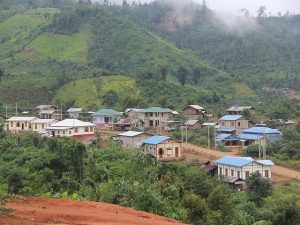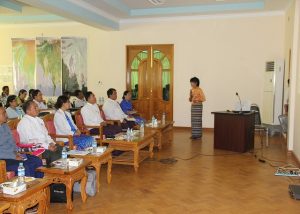Myanmar has a large potential for the development of hydro-power and, on the other hand, the country faces a chronic shortage in its electricity supply. Hydro-power is a clean and renewable source of energy, and it can be developed on a large enough scale to supply the electricity demand of the whole nation. One of the significant challenges of many hydro-power development projects is the need for conservation of biodiversity. It is important to focus on factors such as: environmental policy related to hydro-power projects; fish conservation in the development of hydro-power; socioeconomic index related to hydro-power as well as in the development of economic pillar, social pillar, and environmental pillar.
In the development of economic pillar, it is necessary to focus on agriculture and its export production; the role of consumption as well as production rate; poverty reduction; personal incomes; and the development of tourism. In the development of social pillar, it is entirely focused on national laws, polices, plans, programs, rules, regulations; the events on deprivation and income opportunities; the standard measurement on access to health services, education, water and sanitation, forest and biodiversity resources; and resettlement’s social implications. In the development of environmental pillar, it sustained the state policies and development plans; the key environmental sectors, sustainable forest, biodiversity and watershed; the role of climate change; sustainable biodiversity resources including fauna and flora; sustainable mountain development; safety land management and improved infrastructure development; and urgent development as well as integrated actions between and among authorized persons, scientists, policy makers, stakeholders, decision makers and local inhabitants in the implementation of the agreement for commitment & capacity enhancement for environmental sustainable framework.

Discussion with Village leaders on Socio-economic condition of resettlement area of Upper Paunglaung Project (Photo: Mie Mie Kyaw)
Successful assessment on socioeconomic and environmental survey support the enhancement on new environmental sustainable policy related to biodiversity and Hydro-Power (HP) Projects, through an effective engagement and implementation in the projects’ cycle. In the development of fish conservation in the project area, it focused on water quality analysis by sending collected water and soil to the laboratory in time in order to analyze the standard of quality and the quality of reservoir. It also focused on the role of fish population by surveying the area and its diversity as well as effectively carried on to a better sustainable aquatic ecosystem project management, proper sustainable fish conservation framework, and balance management in the area of HP Projects.

Resettlement area of Upper Paunglaung Project (Photo: Mie Mie Kyaw)
In the implementation of the socioeconomic index related to hydro-power, it is efficiently done as a creation on survey record and it was successfully taken in the resettlement for each household as “Survey on Socio-economic Survey Record”. This survey includes 18 points: (1) Education Standard, (2) Healthcare, (3) Economic Growth, (4) Personal Income, (5) Housings Standard, (6) Access Roads, (7) Religious Buildings Construction, (8) Supply System, (9) Water Sanitation, (10) Community Development, (11) Electricity Supply System, (12) The Standards of Farmlands and Cultivation Lands, (13) Job Opportunities, (14) Livelihood Safeguards, (15) Relocation Standards, (16) Standards of Livings, (17) Environmental Conservation Standards, and (18) Equal Financial Compensation. The survey collected approximately 2500 households in resettlement area due to the implementation of upper Paunglaung HP project. The result may bad at the transition period, but it surely will be a better situation for the economic, social, and environmental sectors in near future.
Workshop on Biodiversity conservation in the development of Hydro-Power in Myanmar, at Ministry of Transport in Nay Pyi Taw (January 22, 2015) (Photo: Mie Mie Kyaw)
The ASEAN-U.S. Science and Technology Fellow working on this survey project has effectively organized a workshop at the Ministry of Transport in Nay Pyi Taw, and successfully linked between and among the ministries, namely the Ministry of Transport, Ministry of Electric Power, Ministry of Environmental Conservation and Forestry, Ministry of Science and Technology, Ministry of Education, and Ministry of Home Affairs.The workshop successfully carried as an integrated way on the development of Biodiversity conservation in hydro-power area, by assessing all comments and suggestions from the workshop’s participants.
Workshop on Biodiversity conservation and its effect on nature, at No (26) State High School, Mandalay (January 27, 2015) (Photo: Mie Mie Kyaw)
A balance is needed between the fluctuation of Biodiversity impacted by a project and communities that stand to benefit from new supply of electricity. There are also often many conflicts on considerations related to saving the environment and the advancement of civilization by the provision of a clean, readily available source of energy. Before, during, and after the implementation of hydro-power projects, major impacts on biodiversity are definitely faced on a small or large scale, depending on the size of the project. Thus, during implementation it is essential that sustainable environmental factors are followed, including EIA (Environmental Impact Assessment), environmental quality analysis, pollution control management and natural resources conservation.Organizational arrangements and design criteria must ensure that the conservation of the biodiversity of the area is in a sustainable state. At the same time it is necessary to ensure adherence to relevant criteria set forth in the guidelines of the World Commission on Hydro-power Dams, conventions of the International Hydro-power Association (IHA), the standards of the Myanmar Government’s policy, and the standard of the World Bank group, and also in particular International Finance Corporation (IFC) Performance Standards and Environment Health and Safety Guidelines. By carefully paying attention to all these various planning guidelines, comprehensive environmental conservation on terrestrial & aquatic animals and its population (dynamics of rare species, common species, endemic species, endangered species, threatened species, and extinct species)will be developed for future hydro-power projects in Myanmar. Indeed, these will ensure a sustainable approach to environmental conservation technology that leads to the proper conservation of biodiversity in the vicinity of hydro-power projects in Myanmar.
About the Author:
Dr. Mie Mie Kyaw is an Assistant Lecturer at the Department of Zoology, University of Pathein, Ministry of Education, Myanmar. She is one of the ASEAN-U.S. Science and Technology Fellows. Her last professional experience was doing an “Assessment of the ecological effects of the Yeywa hydro-power dam” in Myanmar.


